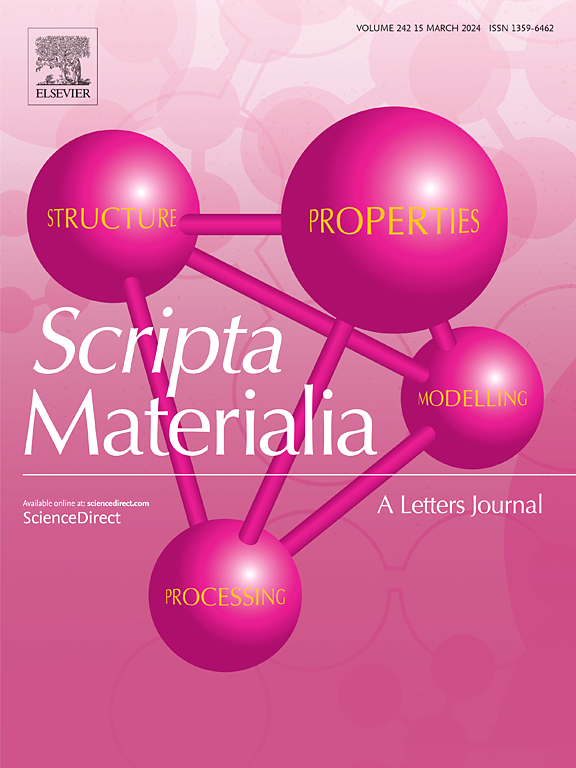向轻量化高熵高温合金方向发展,同时保持环境强度-延展性协同、高温强度和抗氧化性
IF 5.3
2区 材料科学
Q2 MATERIALS SCIENCE, MULTIDISCIPLINARY
引用次数: 0
摘要
传统的高温合金具有优异的高温强度(HTS)、抗氧化性和良好的室温(RT)拉伸延展性,但代价是密度增加或材料成本高。在这里,我们提出了一种轻质(7.53 g/cc) Ni30Co30Cr15V10Fe5Al5Ti2.5Si2.5 (at。%)的高熵高温合金(Ni-HESA)在室温下(1296 MPa, 40%)具有显著的强度-塑性协同作用,在800°C时具有优异的高温高温(600 MPa),在其最复杂的微观结构状态下,在900°C暴露96小时具有等温抗氧化性(抛物线氧化系数~ 3.693 × 10-4 mg2cm- 1s -1)。Ni-HESA中这种微观结构的复杂性源于γ′(L12Ni3(Si, Ti)型)析出物、退火孪晶和γ- fcc内晶粒尺寸模式的存在。矩阵。这些特性通过背应力强化增强了RT的加工淬透性,同时确保了高温下的显微组织稳定性,从而提高了强度和抗氧化性。上述Ni-HESA的性能特征使其成为一种有前途的高温合金,可用于提高燃油效率。本文章由计算机程序翻译,如有差异,请以英文原文为准。

Towards light-weighting high entropy superalloy while retaining ambient strength-ductility synergy, high temperature strength and oxidation resistance
Conventional superalloys offer excellent high-temperature strength (HTS), oxidation resistance, and good room-temperature (RT) tensile ductility, however, at the expense of either increased density or high material costs. Here, we present a lightweight (7.53 g/cc) Ni30Co30Cr15V10Fe5Al5Ti2.5Si2.5 (at. %) high entropy superalloy (Ni-HESA) that achieves a remarkable strength-ductility synergy at RT (1296 MPa, 40 %), excellent HTS (600 MPa at 800 °C), and isothermal oxidation resistance at 900 °C for 96 h exposure (parabolic oxidation coefficient ∼3.693 × 10–4 mg2cm-4s-1) in its most microstructurally complex state. This microstructural complexity in Ni-HESA arises from the presence of γ′ (L12![]() Ni3(Si, Ti) type) precipitate, annealing twins, and grain size modality within the γ-f.c.c. matrix. These features enhance RT work hardenability through back-stress strengthening while ensuring substantial microstructural stability at elevated temperatures, thereby improving both strength and oxidation resistance. The aforementioned property profile of Ni-HESA positions it as a promising superalloy for high-temperature applications, offering enhanced fuel efficiency.
Ni3(Si, Ti) type) precipitate, annealing twins, and grain size modality within the γ-f.c.c. matrix. These features enhance RT work hardenability through back-stress strengthening while ensuring substantial microstructural stability at elevated temperatures, thereby improving both strength and oxidation resistance. The aforementioned property profile of Ni-HESA positions it as a promising superalloy for high-temperature applications, offering enhanced fuel efficiency.
求助全文
通过发布文献求助,成功后即可免费获取论文全文。
去求助
来源期刊

Scripta Materialia
工程技术-材料科学:综合
CiteScore
11.40
自引率
5.00%
发文量
581
审稿时长
34 days
期刊介绍:
Scripta Materialia is a LETTERS journal of Acta Materialia, providing a forum for the rapid publication of short communications on the relationship between the structure and the properties of inorganic materials. The emphasis is on originality rather than incremental research. Short reports on the development of materials with novel or substantially improved properties are also welcomed. Emphasis is on either the functional or mechanical behavior of metals, ceramics and semiconductors at all length scales.
 求助内容:
求助内容: 应助结果提醒方式:
应助结果提醒方式:


